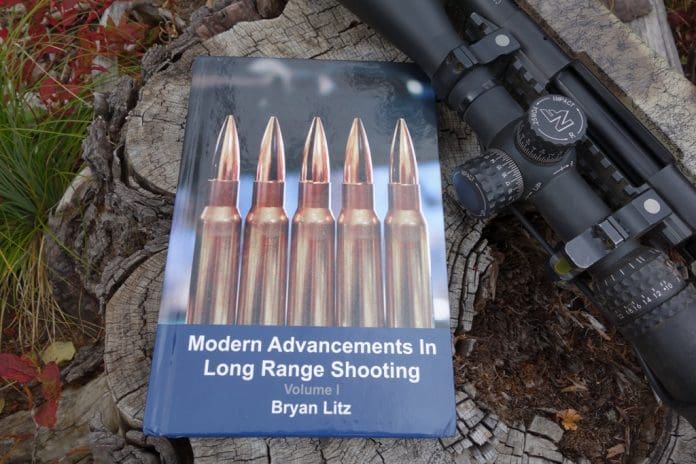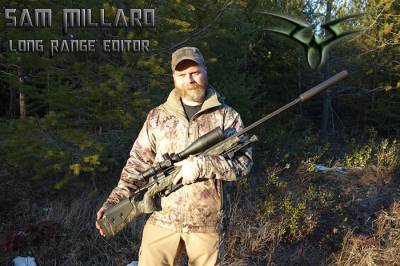I think smart hunters read and read a lot. What better way to perfect your craft when you can’t be afield. I’d like to introduce Sam Millard, Rokslide’s Long Range Editor. Sam has been on our our prostaff since early spring. If you’ve seen his videos, you can tell he knows his stuff. Sam is also a bookworm reading everything he can get his hands on pertaining to hunting and shooting. Recently, he read and reviewed Modern Advancements in Long Range Shooting by Brian Litz. If you’ve ever wanted to shoot well beyond 300 yards, give Sam’s review a once over. What better way to decide if an investment in the book is for you. Show us the good stuff, Sam!
With the popularity of long range hunting and shooting rising every year, equipment manufacturers and information, brokers are scrambling to claim their share of the market. With the amount of gear available and Internet access to forums, blogs, etc., it can be daunting to figure out what works and what doesn’t…and why.
In Modern Advancements In Long Range Shooting: Volume 1, by Brian Litz of Applied Ballistics, he tests several ideas concerning the making of a long range shot and the tools we use to accomplish it. He uses a scientific method rather than relying on anecdotal evidence. In the introduction, he states, “Rather than rely on popular opinion or marketing hype, we approach the matter with careful experimentation which is then described in a way that’s easy to understand and apply.”
The book is broken down into four parts and 18 chapters, covering four distinctly different areas of research:
Part 1 This section covers stability issues and how they affect bullet flight. One of the most interesting topics in these five chapters concerns the effect of fast twist rifling on velocity and precision. The testing showed that fast twist rifling (which is necessary for stabilizing long-for-caliber, high B.C. bullets) has no practical, negative impact on precision or muzzle velocity.
Part 2 is an equipment discussion, covering rifles, optics, and bullets. The first two chapters talk about rifles and scopes. Mr. Litz asks the question, “What’s holding us back?” He proceeds to address issues such as limitations on rifles (magazine length restrictions and barrel twist rates) and optics (tube diameters and accurate turret adjustments, along with mounting systems).
The last three chapters of this section are all about bullets and the advancements made in designs that improve their performance at long range.
Chapter 9, titled “Rise of the 30 Caliber” seeks to find out what has limited the long range shooter who favors this popular caliber. If you have ever wondered how the excellent 215 and 230 grain Hybrid bullets from Berger came to be, you will find it here!
Part 3 looks at predictive modeling and how it is used to form ballistic solvers. There is an extensive discussion about the limitations placed on a ballistic program simply due to the inputs the shooter provides. “Garbage in, garbage out,” is mentioned and explained in detail. Also, each input is looked at closely and prioritized according to its effect on the output.
Chapter 12 of this section covers secondary effects on flight such as coriolis, spin drift, and aerodynamic jump. This chapter contains some of the best information I have ever read on this topic.
Part 4 returns to an equipment discussion, including an extensive and interesting test with several chronographs to determine accuracy and precision of each unit. If you want to know how popular chronographs stack up to each other, this is by far the most thorough testing that I have seen. Also covered are laser rangefinders, how they work, and what their limitations are. Contributing author, Nick Vitalbo, takes over with the laser testing. He also adds a chapter on measuring wind with a laser device, all the way to the target. This is some interesting technology that is being worked on now at Applied Ballistics.
In closing, I would say that if you’re looking for a “how-to” long range book, this ain’t it. However, if you want to expand your knowledge of the whys and whats, this is an excellent resource. As a dedicated long range shooter, I’ve always thought those last two questions were more important than the first one.
There you have it Rok Blog people! True to our generous nature here at Rokslide, we want to get a copy of this book in your hands. You’ve got two choices:
1) Buy one here: Applied Ballistics, The Science of Accuracy Tell them Rokslide sent you.
2) Win one by simply “Liking” this post on Rokslide’s FB page here AND post in the comments section below your maximum effective rifle range on big game.
I’ll go first: under ideal conditions, I can shoot to 600 yards on mule deer.
I’ll draw from those lists in November and post the winner here. Don’t forget to subsribe to the Rok Blog (upper right under Fitness/Other at “Subscribe to blog” so you’ll recieve instant winner notification when I post.
Coming up on the Rok Blog in November: I’ll be drawing for a winner for the Vortex Vulture 15×56 binoculars (see Win the Vortex 15×56 Binocular), posting a review on Extreme Hardcore Gear’s Force Recon Scope Rings by Sam Millard, and posting a day-by-day blog on a backcountry mule deer hunt by yours truly.
It’s gonna be a great month!





















Under ideal conditions, I can shoot to 600 yards on mule deer.
Thanks Sam ! I have read a few of Brians articles but I need to break down and get his books.
Robby, as usual, you have top notch info. This was a good read. Thank you. My son would like this book, he likes to shoot long distance. He is headed to basic training next Tue, so please keep him in your prayers. As far as maximum effective range, I saw him drop a yote from a kneeling position 449 yards with his .270.
Tell your son thanks for his service and that he’s in my prayers and good shot on the 449 yote!
Thank you Robby, I did, and he says Thank you.
Thanks for the review Sam. I look forward to readimg his book.I am going out tomorrow to practice out to 1000 again and get my son out to 600 yards comfortably.
Looking forward to hearing the day by day for your mule deer hunt!
As far as distance, I haven’t done any long range hunting. 🙁 Hopefully my upcoming wedding will produce a gun fund to get a nice rifle.
I can and have went out to 500 yds but prefer closer ranges.
I am a beginner and practice out to 400 with my .270, would love to get more comfortable farther out.
My maximum effective range on mule deer is 440 yards.
Comments are closed.